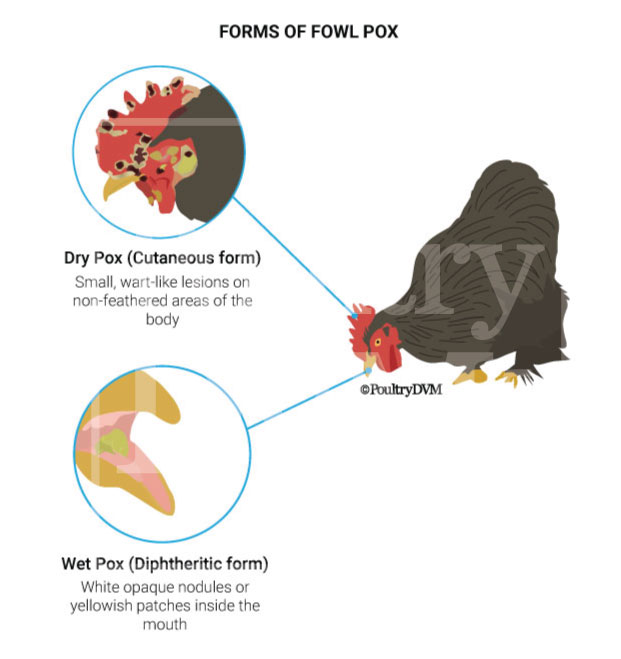Fowl pox is a slow-spreading viral disease of chickens characterized by lesions on the unfeathered skin areas and/or mucous membranes of the oral cavity, larynx, or trachea. The disease is caused by the avian poxvirus which is classified as at least three different strains or types, including fowl poxvirus (FPV) that affects chickens and turkeys, pigeon poxvirus (PPV) that occurs in pigeons, and canary poxvirus (CPV) that affects different species of wild birds. Each virus strain can only cause disease within certain species of birds. For example, chickens are not affected by infection with pigeon pox virus, and vice versa.
Forms of Fowl Pox
There are two different forms of fowl pox that can occur in chickens--classified as a dry (cutaneous) form and wet (diphtheritic) form.
Cutaneous or "dry" pox form
The cutaneous or "dry" pox form is the most common. Typical pox lesions are small, wart-like growths on the skin of unfeathered areas (face, comb, wattles, eyelids, legs, and feet). These initially appear as small, yellow eruptions which gradually increase in size. Pox lesions will also change color as they grow larger, and turn into dark brown, roughened, dry scabs. The scabs will usually last about 2 to 4 weeks, after which they will loosen and drop off on their own, leaving smooth scar tissue underneath. These dry scabs contain the poxvirus and are highly infectious to other flock members.
In cases where pox lesions develop near the chicken's eyes, clinical signs may initially present as mild redness and irritation and quickly progress to swelling of the eyelid and the development of ulcerative lesions along the edges of the eyelid. The eyelids often become sealed shut with caseous discharge or with dry crusting scabs which fall off within two weeks. While lesions start to develop, affected chickens are at an increased risk of secondary infection. To minimize risk of infection, efforts should be made to help keep pox lesions clean.
Diphtheritic (wet pox) form
The diphtheritic form of fowl pox is associated with higher mortality in birds. It causes plaques (also referred to as yellow canker lesions) to develop within the oropharynx (inner mouth and throat) of birds. These may start out as tiny white nodules which merge together to form raised-yellow white cheesy patches. If lesions are located in the upper digestive and respiratory tract, it may cause chickens to reduce their feed intake and have difficulty swallowing. Other respiratory signs may also be apparent, depending on the severity which can range from mild to severe.
How Fowl Pox is Transmitted
Fowl pox is transmitted to flocks through biting arthropods (primarily mosquitoes) and introduction of a new bird into the flock who is latently infected with the virus. Once a mosquito feeds on an infected bird, it is able to keep the virus in the salivary glands for up to 8 weeks. When mosquitoes bite another chicken, they are capable of transmitting the poxvirus to them. In fact, one mosquito can infect several chickens after feeding on a single bird infected with the virus.
Once one flock member is infected, the chicken is capable of transmitting the virus to other flock members by:
- Through scratches or broken skin and mucous membranes: It is often associated with flock members pecking, fighting, or scratching at one another.
- Dried pox scabs: The dried scabs that fall off of the chickens during the course of the disease can also serve as a source of infection in chicken flocks. The virus can survive in the dried scabs for months or even years.
Fowl Pox Treatment in Chickens
Generally, fowl pox is self-limiting, and treatment is primarily supportive care. Antibiotics may be needed if secondary infection develops.
